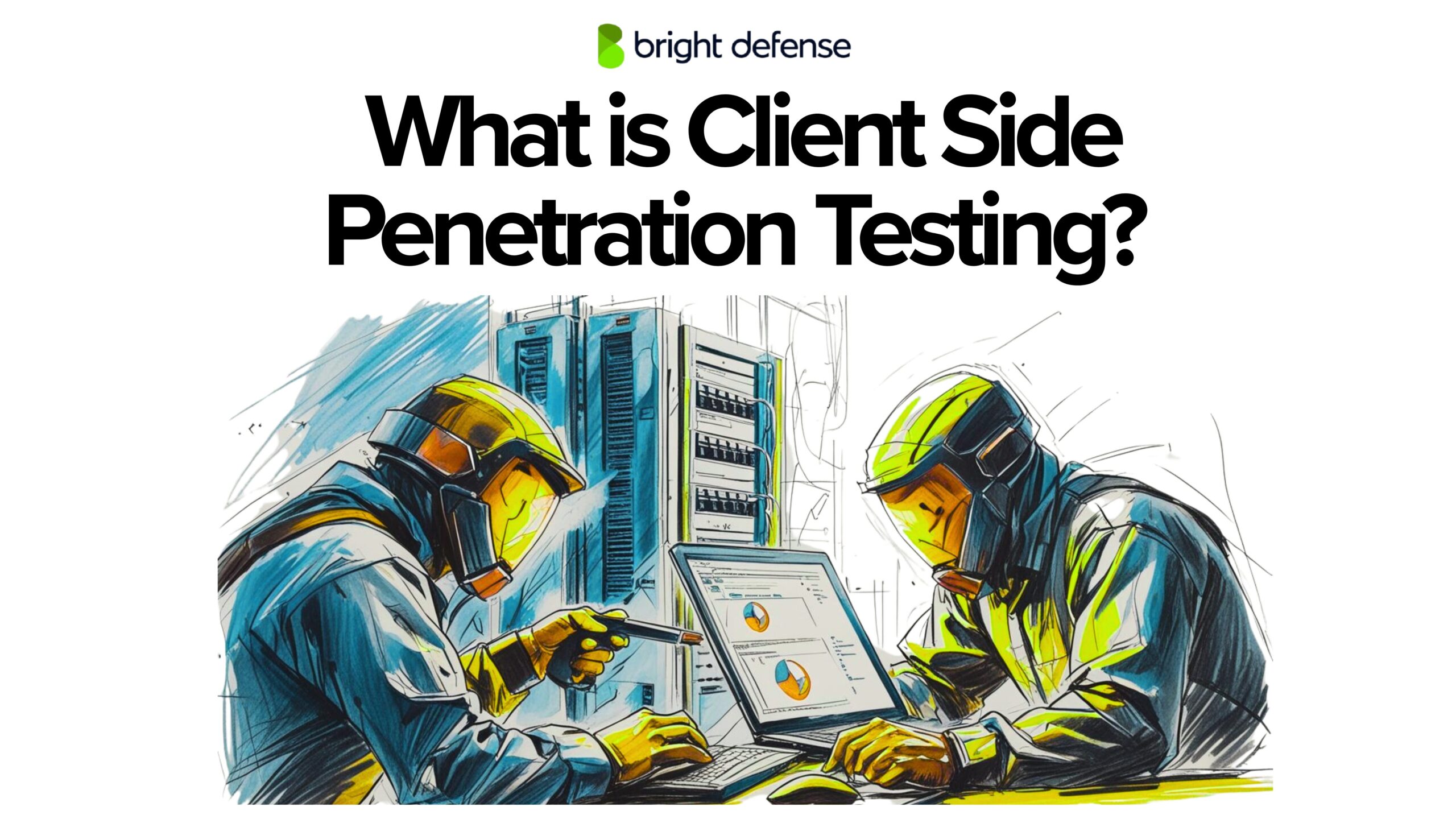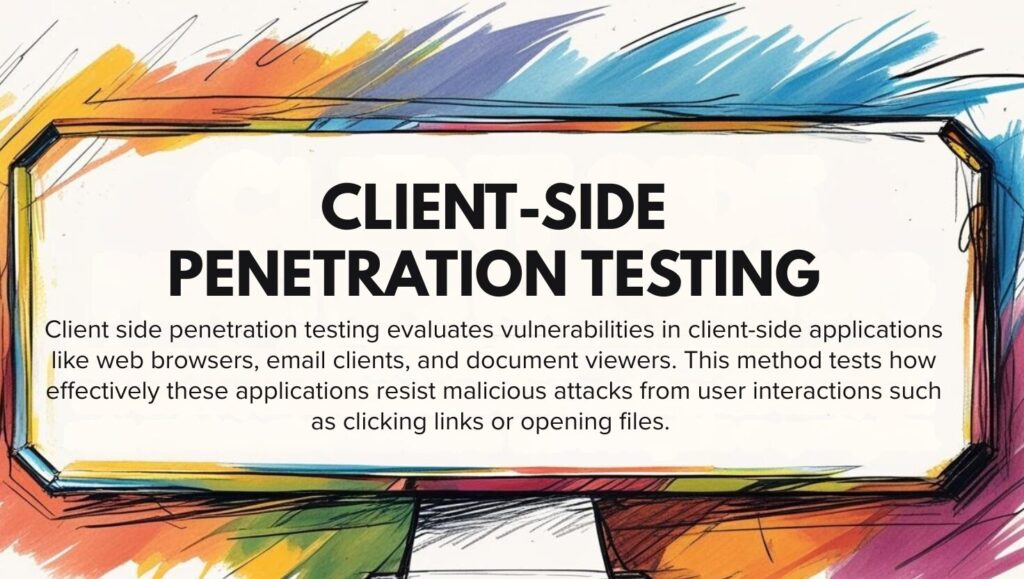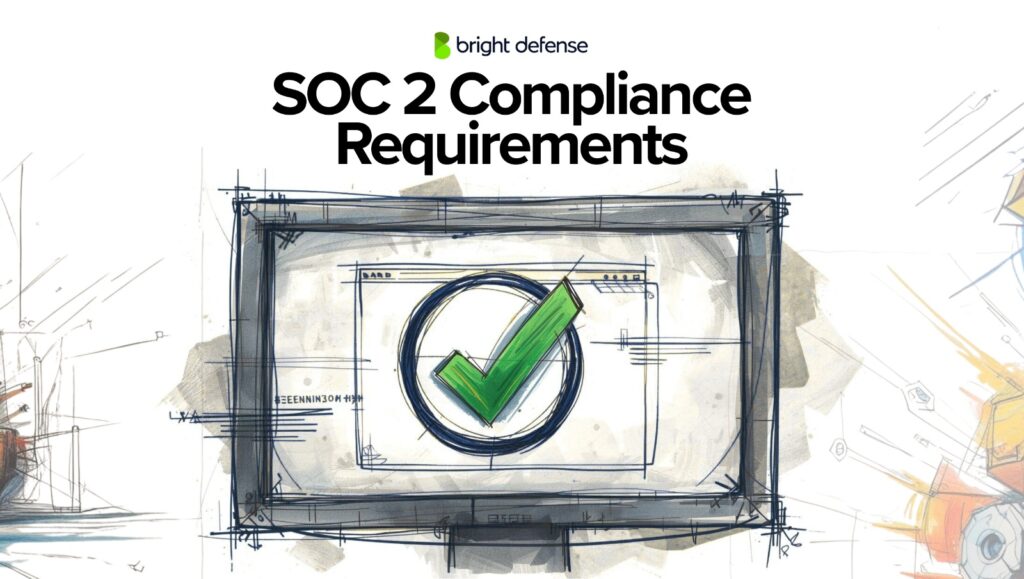
What is Client Side Penetration Testing?
Over 90% of cyber attacks begin with phishing or other client-side tactics that target employees directly. Attackers exploit everyday tools such as email clients, browsers, and document readers to gain initial access. Client-side penetration testing focuses on these high-risk entry points, helping organizations find and fix vulnerabilities before they’re used in real attacks.
Key Takeaways
- Over 90% of cyber attacks begin with phishing or other client-side tactics targeting employee tools like browsers and email
- Client-side penetration testing simulates attacks on user-facing software to find exploitable weaknesses before real threats do
- The process includes social engineering, payload delivery, and system monitoring to reveal how well defenses like antivirus or EDR perform
- Tools like Metasploit, BeEF, Burp Suite, and SET help testers uncover security gaps in common client applications
- Bright Defense offers focused client-side testing with clear reports and practical fixes to reduce endpoint-driven risk
Client Side Penetration Testing Definition

Client side penetration testing evaluates vulnerabilities in client-side applications like web browsers, email clients, and document viewers. This method tests how effectively these applications resist malicious attacks from user interactions such as clicking links or opening files.
Why Do You Need Client Side Penetration Testing?
Client-side testing focuses on software and tools used directly by employees which is a common targets for attackers. Here are some of the reasons as to why you may need client side penetration testing:
- Finds weaknesses in employee-facing apps like browsers, plugins, and desktop software.
- Protects sensitive data from exposure through poorly secured endpoints.
- Blocks social engineering attacks by testing real-world tactics like phishing.
- Checks if endpoint defenses like antivirus and EDR are working as expected.
- Exposes risks in third-party software used within the organization.
- Supports compliance with standards like PCI DSS, HIPAA, and ISO 27001.
- Reduces phishing and malware risks tied to user interaction.
- Prevents brand damage caused by endpoint-driven breaches.
How is Client Side Penetration Testing Performed?
Client-side penetration testing focuses on how attackers might exploit user-facing applications and employee behavior. The process follows several key steps to simulate real-world threats and assess the security of endpoint environments.
- Software and Environment Review: Client-side testing usually starts with collecting data on software installed on employee devices, such as browsers, PDF readers, and third-party plugins.
- Configuration and Version Analysis: Testers examine software versions, configurations, and usage to understand the environment and possible weak points.
- Vulnerability Scanning: Vulnerability scanners are often used to detect known flaws in client applications, especially those with available public exploits.
- Social Engineering Simulation: Social engineering is commonly included, using simulated phishing emails or fake attachments to see how users interact with potential threats.
- Payload Delivery: Malicious payloads may be delivered through crafted documents or links, replicating attack methods seen in real incidents.
- Exploitation Attempts: Exploitation efforts focus on areas like browser plugins or document handlers, testing whether attackers could execute code or access restricted data.
- System Response Monitoring: System behavior is monitored during these attacks to observe how applications respond and whether controls like antivirus or EDR stop the intrusion.
- Reporting and Recommendations: After testing, findings are documented in a report that outlines successful exploits, technical details, and suggested remediation steps.
- Re-testing After Fixes: A re-testing phase is often performed once fixes are applied, confirming that vulnerabilities are no longer present.
What Tools Are Used for Client Side Penetration Testing?
Several tools facilitate client-side penetration testing:
- Metasploit Framework: Popular for simulating attacks, Metasploit offers diverse payloads and exploits for various applications.
- BeEF (Browser Exploitation Framework): Specializes in testing browser vulnerabilities, allowing testers to explore weaknesses and inject exploits into client browsers.
- Burp Suite: Primarily for web application security testing, Burp Suite helps in identifying vulnerabilities like cross-site scripting (XSS) and injection attacks.
- OWASP ZAP: Open-source web application scanner detecting vulnerabilities including SQL injection, session hijacking, and cross-site scripting.
- Social Engineering Toolkit (SET): Enables simulation of phishing attacks, testing user susceptibility to deceptive emails and malicious links.
- Wireshark: A network protocol analyzer helpful in inspecting client-server interactions, capturing and examining data traffic for vulnerabilities.
- Nessus: Vulnerability scanner identifying known security flaws in client-side applications, assisting in detailed vulnerability assessment.
These tools, combined with manual testing, provide extensive insights into client-side vulnerabilities and security weaknesses, aiding in robust protection against potential threats.
How We Help You Strengthen Client-Side Security
At Bright Defense, we focus on protecting the part of your environment that attackers often target first: the client side. Our client-side penetration testing service is built to find real gaps before real threats do.
We simulate practical, high-impact attack scenarios using current tools and techniques. This helps us uncover vulnerabilities that malware, phishing lures, and targeted exploitation could otherwise exploit. From browser-based flaws to insecure local storage and exposed APIs, we cover the full surface area that client-side threats aim for.
You don’t get generic results. You get focused reports, clearly written, with prioritized fixes and potential business impacts laid out. Our team works closely with yours, helping translate technical findings into strategic decisions.
Through regular testing, we help reduce risk, strengthen your application security controls, and support your compliance efforts without slowing down your business. If client-side exposures are keeping you up at night, we’re ready to help you take control.
Recommended Frequency for Client-Side Penetration Testing
Maintaining the security of client-side components requires regular assessments to catch vulnerabilities that may arise through frequent changes, third-party integrations, or evolving threats. The following breakdown outlines how often companies should run these tests.
Frequency for Client-Side Penetration Testing Summary Table
This table provides a quick reference for the testing frequency based on different contexts and risk levels.
| Scenario | Recommended Testing Frequency |
| Standard environments | Once a year |
| High-risk industries or sensitive data | Quarterly or more frequently |
| Major changes to applications | After each major change |
| Regulatory or compliance-driven sectors | As required by standards |
| Ongoing development or fast release cycles | Continuous or monthly |
Does Client-Side Security Require Vulnerability Scanning or Penetration Testing?
Client-side security requires both vulnerability scanning and penetration testing, as they address different risks. Vulnerability scanning is automated and helps catch known issues like outdated libraries, exposed configuration files, or hardcoded secrets. It’s useful during development for quick, recurring checks but often misses logic-based flaws.
Penetration testing, on the other hand, involves manual analysis to simulate real-world attacks. It’s essential for finding complex issues like DOM-based XSS, insecure use of browser storage, or broken client-side controls. While scanning offers speed and frequency, testing provides depth and context. Using both methods together gives more reliable protection against client-side threats.
What Are the Biggest Client-Side Security Vulnerabilities?
Web applications face a range of security threats that can compromise data and user trust. Below are some of the most common vulnerabilities, their types, and how they can be prevented:
1. Cross-Site Scripting (XSS)
XSS occurs when attackers inject malicious scripts into webpages viewed by others. The script executes in the victim’s browser, allowing the attacker to steal session tokens, cookies, or perform actions on behalf of the user.
Types
- Stored XSS: Payload is saved on the server and delivered to users.
- Reflected XSS: Payload is reflected off a web response (e.g., via URL).
- DOM-based XSS: Happens within the browser, manipulated through JavaScript.
Defense
- Input validation and output encoding
- Use of frameworks with built-in protection (e.g., React)
- Content Security Policy (CSP)
2. Cross-Site Request Forgery (CSRF)
CSRF tricks users into performing actions they didn’t intend, using their authenticated session (e.g., changing passwords or transferring funds).
Example
A malicious link or image forces the browser to send a request to another site where the user is already logged in.
Defense
- Use anti-CSRF tokens
- Verify request origins (e.g., SameSite cookies)
- Require re-authentication for sensitive actions
3. Clickjacking
Clickjacking hides a UI element (like a button) behind a seemingly safe interface. The user thinks they’re clicking on one thing, but they’re actually interacting with another.
Example
An attacker could overlay a “Play” button over a hidden “Confirm Purchase” frame.
Defense
- Use X-Frame-Options: DENY or Content-Security-Policy: frame-ancestors ‘none’
- Implement UI integrity checks
4. Insecure DOM Manipulation
Improper handling of the DOM using innerHTML, document.write, or jQuery’s .html() can open the door for script injection or unintended behavior.
Defense
- Avoid dynamic HTML injection
- Use safer DOM APIs like textContent
- Validate input before using it in the DOM
5. Insecure Local Storage
Storing sensitive information like tokens, passwords, or PII in local storage, session storage, or IndexedDB without encryption or access control.
Risks
Data is accessible to any script running on the page, including third-party ones.
Defense
- Avoid storing sensitive data in the browser
- Use short-lived tokens with backend validation
- Obfuscate and encrypt when necessary
6. Exposed APIs
Client-side code may expose API endpoints or secrets, especially in JavaScript bundles.
Risks
Attackers can reverse-engineer apps to retrieve endpoints, tokens, or logic.
Defense
- Do not embed secrets or business logic in client-side code
- Implement API rate-limiting and authentication
- Obfuscate code where needed
7. Third-Party Script Injection
Using external libraries or ads without strict validation introduces risks if those sources are compromised.
Defense
- Use Subresource Integrity (SRI)
- Host critical scripts locally
- Apply CSP to control script execution
8. Broken Access Control on the Client
Client-side checks (e.g., “if user.role == admin”) provide no real protection. Attackers can bypass these through browser dev tools or script tampering.
Defense
- Implement access control on the server
- Treat client logic as untrusted
9. Sensitive Data Exposure in Source Code
Developers sometimes accidentally leave API keys, credentials, or config files in client-accessible code.
Defense
- Scan builds for secrets before deployment
- Use environment variables on the server
- Minify and obfuscate production code
How Can Bright Defense Help You With Client-Side Pen Tests?
Bright Defense helps organizations find and fix vulnerabilities in client-side applications and devices. Our testing focuses on areas attackers often target, helping you strengthen defenses before issues arise.
Why Choose Bright Defense for Client-Side Penetration Testing?
- Targeted Testing Plans: Choose from the Ignite Plan for small teams, the Accelerate Plan for growing businesses, or the Apex Plan for larger organizations needing broader coverage.
- Proven Methods: We simulate real-world threats against client applications, endpoints, and user environments, checking for weak points that attackers could exploit.
- Compliance Support: Our services meet standards like PCI DSS, HIPAA, SOC 2, and ISO 27001, helping you stay ahead of compliance needs.
- Detailed Reporting: We deliver clear reports with specific remediation steps, helping your teams fix vulnerabilities quickly and effectively.
FAQs
Client side penetration testing assesses vulnerabilities in end-user applications like browsers and email clients to protect against exploitation through common user interactions.
The three types are Black Box (no prior information), White Box (full access provided), and Grey Box (partial knowledge).
Vulnerability Assessment identifies vulnerabilities without exploitation, whereas Penetration Testing actively attempts to exploit identified vulnerabilities.
Proof of Concept (PoC) demonstrates that a vulnerability is exploitable, proving the potential impact of a discovered security weakness.
Typical vectors include cross-site scripting (XSS), clickjacking, DOM-based vulnerabilities, malicious file execution, and unsafe JavaScript functions in web applications.
Testers use tools like Burp Suite, Browser Exploitation Framework (BeEF), OWASP ZAP, and browser developer tools to identify and exploit client-side flaws.
Client-side testing focuses on what runs in the user’s browser or system—scripts, DOM interactions, and UI behavior—while server-side testing targets backend logic, databases, and server configurations.
It helps catch vulnerabilities that can be exploited without breaching the server, such as injecting malicious scripts, hijacking sessions, or stealing data through insecure front-end logic.
A typical PoC might show an alert box from an XSS payload or demonstrate a session token leak using crafted JavaScript in a browser environment.
Yes, issues like XSS, insecure deserialization, and broken access control often originate on the client side and are included in the OWASP Top 10 risk categories.
Get In Touch



